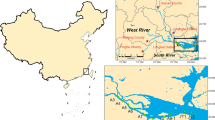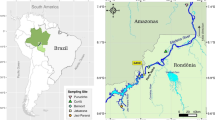Abstract
Previous studies in the Amazon Basin and the Upper Pantanal show widespread mercury contamination of fish and water as a result of gold mining, and subsequent volatilization of mercury during the recovery process. A study was initiated to assess whether atmospheric transport of mercury to the south has resulted in elevated levels in water and fish in the Lower Pantanal. Water samples were collected from streams and rivers from the Pantanal (Mato Grosso do Sul) down into the southernmost state of Brazil (Rio Grande do Sul) for total Hg concentration and oxygen isotopic analyses. Based on oxygen isotopes and conductivity, surface water samples can be considered as mixtures of three endmembers: groundwater, rain and “aged” surface water. Lowest concentrations (<2 ng/L) of total Hg were observed in the northernmost samples, especially those associated with the groundwater sources. Further south, Hg concentrations tended to increase, but higher concentrations (>2 ng/L) likely reflect direct input from more localized watershed sources. Fish collected from streams in the Pantanal had extremely low concentrations of total Hg regardless of their size or feeding habit, although one large carnivorous fish (>2 kg) had concentrations approaching 400 ng/g wet wt. All concentrations, however, were considerably lower than those observed in similar species from the region of the Amazon Basin affected by gold mining.



Similar content being viewed by others
References
Agostinho AA, Gomes LC, Suzuki HI, Júlio HF (2004) Migratory Fishes of the Upper Parana Basin, Brazil. Chap 2. In: Carolsfield J, Harvey B, Ross C, Baer A (eds) Migratory fishes of South America. Biology, Fisheries, and Conservation, World Fisheries Trust/World Bank/IDRC, p 380
Bonotto DM (2006) Hydro(radio)chemical relationships in the giant Guarani aquifer, Brazil. J Hydrol 323(1–4):353–386
Carreon-Diazconti C, Nelson ST, Mayo AL, Tingey DG, Smith M (2003) A mixed groundwater system at Midway, UT: discriminating superimposed local and regional discharge. J Hydrol 273(1–4):119–138
De Lacerda LD, Salomons W, Pfeirffer WC, Bastos WR (1991) Mercury distribution in sediment profiles from lakes of the high pantanal, Mato Grosso State, Brazil. Bigeochem 14:91–97
Dórea JG, Barbosa AC, Souzade J, Fadini P, Jardim WF (2004) Piranhas (Serrasalmus spp.) as markers of mercury bioaccumulation in Amazonian ecosystems. Ecotox Environ Safe 59:57–63
Fadini PS, Jardim WF (2001) Is the Negro River Basin (Amazon) impacted by naturally occurring mercury? Sci Tot Environ 275:71–82
Forsberg BR, Jardim WF, Zeidemann VK et al (1999) The biochemistry of mercury in the Negro river basin (Brazilian Amazon). In: Barbosa J, Melamed R, Villas BR (eds) Mercury as a global pollutant—Fifth International Conference, 23–27 May 1999, Rio de Janeiro, Brazil. CETEM-Center for Mineral Technology, p 153
Greene EA (1997) Tracing recharge from sinking streams over spatial dimensions of kilometers in a karst aquifer. Ground Water 35(5):898–904
Hachiya N, Takizawa Y, Hisamatsu S, Abe T, Abe Y, Motohashi Y (1998) Atmospheric mercury concentrations in the basin of the Amazon, Brazil. Environ Health Prevent Med 2:183–187
Hylander LD, Pinto FN, Guimarães JRD, Meili M, Oliveira LJ, Castro e Silva E (2000) Fish mercury concentration in the Alto Pantanal, Brazil: influence of season and water parameters. Sci Tot Environ 261:9–20
Kehrig HA, Malm O, Akagi H, Guimarães JRD, Torres JPM (1998) Methylmercury in fish and hair samples from the Balbina Reservoir, Brazilian Amazon. Environ Res 77:84–90
Malm O (1998) Gold mining as a source of mercury exposure in the Brazilian Amazon. Envion Res 77:73–78
Martin JM, Whitfield M (1983) The significance of the river input of chemical elements to the ocean. In: Wong CS, Boyle E, Bruland KW, Burton JD, Goldberg ED (eds) Trace metals in sea water. Plenum Press, Newyork, p 920
Nelson ST (2000) A simple, practical methodology for routine VSMOW/SLAP normalization of water samples analyzed by continuous flow methods. Rapid Commun Mass Spectrom 14(12):1044–1046
Resende EK, Marques DKS, Ferreir LKSG (2008) A successful case of biological invasion: the fish Cichla piquiti, an Amazonian species introduced into the Pantanal, Brazil. Brazil J Biol 68:10–21
Reys P, Sabino J, Galetti M (2009) Frugivory by the fish Brycon hilarii (Characidae) in western Brazil
Sharp ZD, Atudorei V, Durakiewicz T (2001) A rapid method for determination of hydrogen and oxygen isotope ratios from water and hydrous minerals. Chem Geol 178(1–4):197–210
Smith RG Jr (1993) Determination of mercury on environmental samples by isotope dilution/ICP mass spectrometry. Anal Chem 65(18)
Veiga MM, Hinton J, Lilly C (1999) Mercury in the Amazon: a comprehensive review with special emphasis on bioaccumulation and bioindicators. Proc. NIMD (National Institute for Minamata Disease) Forum’99 Oct. 12–13, Minamata, Japan 19–39
Williams AE, Rodoni DP (1997) Regional isotope effects and application to hydrologic investigations in southwestern California. Water Resour Res 33(7):1721–1729
Author information
Authors and Affiliations
Corresponding author
Rights and permissions
About this article
Cite this article
Windom, H.L., Niencheski, L.F., Wells, D. et al. The use of oxygen isotopic ratios to identify natural and anthropogenic mercury concentrations in the Lower Brazilian Pantanal. Environ Earth Sci 65, 547–553 (2012). https://doi.org/10.1007/s12665-011-1369-1
Received:
Accepted:
Published:
Issue Date:
DOI: https://doi.org/10.1007/s12665-011-1369-1




